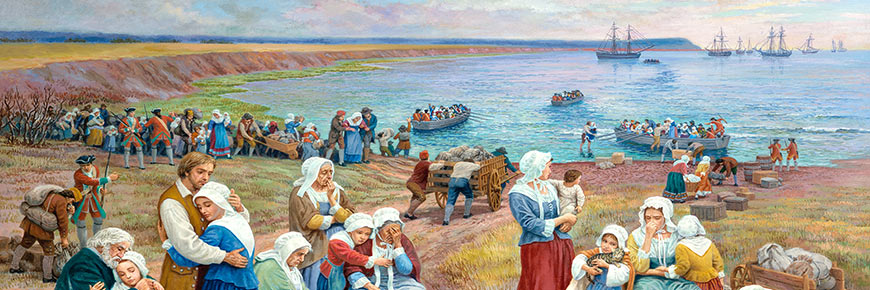
The great upheaval
Fort Beauséjour – Fort Cumberland National Historic Site
On the 28th of July 1755, the Council in Halifax ordered the deportation of the Acadians in Nova Scotia to the British-American colonies along the eastern seaboard. The first of the announcements and round-ups of Acadians occurred in August at Fort Cumberland, a month before a similar process was followed at Grand-Pré and Pisiquid.
Between October 1755 and until 1762, hundreds of Acadian families were forced onto ships and transported to these colonies and to England and France. Between 6,000 and 7,000 Acadians were removed from their homeland. About 1,100 individuals from the Beauséjour region were deported while another 2,000 escaped to Canada and Île Saint-Jean or took refuge along the Miramichi River in the course of the next few years.
The resistance
However, a group of Acadians stayed behind, under the leadership of Charles de Boishébert and Joseph Broussard known as Beausoleil, and resisted the British at Fort Cumberland. After several altercations, including one in the summer of 1755 at Village-des-Blanchard (now Hillsborough, N.B.) and another one in January 1759 at Bloody Bridge near the fort of Beauséjour, the Acadian partisans surrendered to the British authorities.
Times of hardship
The Acadian families who took refuge along the Miramichi River and Restigouche Bay faced enormous hardships. After living as fugitives in the woods for several years, many of them were obliged to give themselves up following a British attack in 1761. About 200 Acadian men, women and children were thus taken prisoner and transported to Fort Cumberland, Fort Edward (Windsor, N.S. ) and Halifax.
By 1764 there were about 73 Acadian families or 388 individuals living in makeshift huts in the vicinity of Fort Cumberland. These families were able to survive thanks to rations they received from the British authorities in exchange for menial work.
After 1764, the families were no longer under surveillance and were able to move away to found new villages in New Brunswick and Nova Scotia. They were later joined by compatriots who were exiled to the Anglo-American colonies, Canada, France, and elsewhere. Gradually, the foundations were laid for a new Acadie.
Next part: The start of the British occupationRelated links
- Long before the Fort: Acadian settlement
- First warfare
- Zone of contention, place of growth
- The construction of a fort at Beauséjour
- Life inside the Fort during the French regime
- The Acadians and the fort
- Tensions of the 1750s
- The siege of 1755
- The start of the British occupation
- Settlers from Yorkshire
- The 1776 siege of Fort Cumberland
- Changes to the fort after the second siege
- Creation of the national historic site
- Archeological digs
- Date modified :